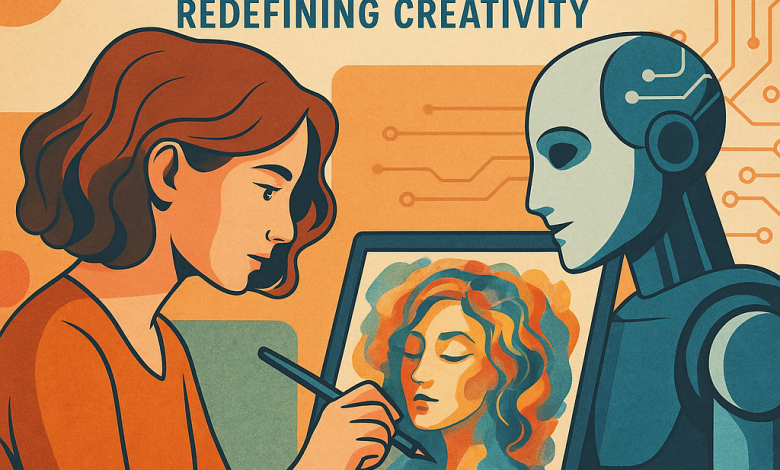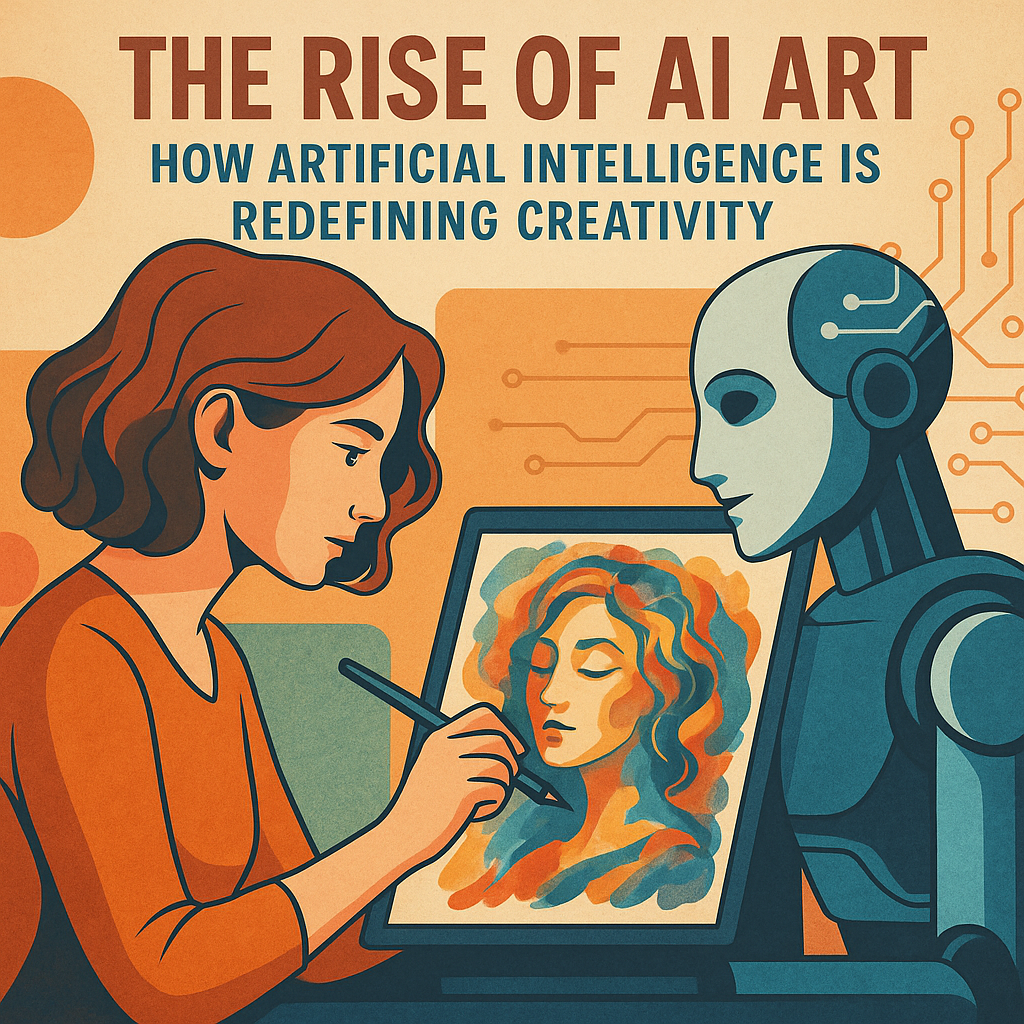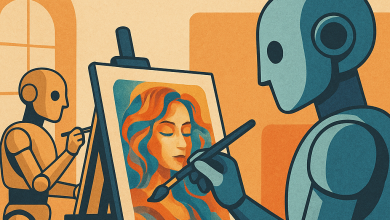The Rise of AI Art – How Artificial Intelligence Is Redefining Creativity
Explore how Artificial Intelligence is reshaping modern art and digital creativity. Learn the tools, ethics, and opportunities behind the rise of AI-generated art in 2025.

The Rise of AI Art – How Artificial Intelligence Is Redefining Creativity
Artificial Intelligence has reached a point where it no longer belongs exclusively to science labs or data scientists. Today, it paints, composes, designs, and inspires. AI Art — the intersection of human imagination and machine learning — has become one of the most profound cultural shifts of our generation.
From viral images created with Midjourney and DALL·E to professional tools like Adobe Firefly and Runway ML, AI is redefining what it means to create. The role of the artist is evolving, not vanishing — and this transformation is giving rise to an entirely new creative movement.

What Exactly Is AI Art?
AI Art refers to visual works — paintings, illustrations, photographs, animations — that are generated or enhanced using artificial intelligence algorithms.
These systems learn from billions of images, identifying patterns in color, composition, and texture. Through text prompts or reference inputs, the AI then generates new, original artworks.
While this process sounds technical, it’s built on the same foundation as traditional art: creativity, emotion, and communication. The only difference? The brush is now powered by data and algorithms.
A Brief History of AI in Art
AI’s involvement in art began decades ago. In the 1970s, researchers experimented with algorithmic art, generating abstract patterns using mathematical rules.
But it wasn’t until deep learning and neural networks emerged in the 2010s that AI art gained mainstream attention. In 2018, Christie’s auctioned its first AI-generated painting, “Portrait of Edmond de Belamy,” for $432,500 — a milestone that shocked the art world.
By 2025, AI-driven platforms like Adobe Firefly, Midjourney v6, and Leonardo AI have democratized this process. Anyone with imagination can now create a masterpiece without mastering painting techniques.
The Tools Powering the AI Art Revolution
1. Adobe Firefly
Adobe’s Firefly integrates AI creation directly into the Creative Cloud ecosystem. Users can type prompts, adjust styles, and generate editable PSD files. Its commercial-use licensing model makes it the most reliable tool for professionals.
2. Midjourney
Midjourney is known for its cinematic, surreal aesthetic. It runs through Discord, focusing on artistic depth rather than strict realism. Designers and marketers use it to visualize concepts rapidly.
3. DALL·E 3
Created by OpenAI, DALL·E 3 offers powerful prompt comprehension and detailed outputs. Its integration with ChatGPT allows text-based creative brainstorming and instant visual generation.
4. Leonardo AI & Stable Diffusion
Leonardo AI combines open-source flexibility with user-friendly controls. Stable Diffusion, meanwhile, allows local AI art creation, enabling full customization and privacy.
How AI Art Is Changing Creative Industries
AI art isn’t replacing designers — it’s augmenting their capabilities.
Here’s how professionals are already using it:
-
Advertising: Generate campaign concepts in seconds.
-
Fashion: Visualize new collections before manufacturing.
-
Film & Gaming: Create storyboards, environments, and concept art rapidly.
-
Education: Teach students design principles interactively.
In the past, visual exploration was expensive and time-consuming. Now, with AI, designers can iterate faster and focus their human energy on storytelling and aesthetics.
The Ethical Debate – Can Machines Be Artists?
No discussion of AI art is complete without addressing the controversy.
Critics argue that AI models “borrow” from existing artworks without crediting their creators. Artists worry that their styles may be replicated without permission. This raises legitimate concerns about copyright, originality, and the nature of creativity itself.
Supporters, on the other hand, view AI as a collaborative partner, not a thief. Just as a camera didn’t kill painting, AI won’t destroy art — it will expand what art can be.
Adobe, for instance, ensures Firefly is trained only on licensed and rights-safe datasets, offering creators full commercial usage rights — a responsible path forward for ethical AI creation.
The Human Element in AI Art
The misconception that AI replaces creativity misses the core truth: AI lacks emotion, intention, and narrative purpose.
It can produce visuals, but not meaning. The human artist still drives concept, direction, and emotional depth.
Great AI artists are not those who rely entirely on algorithms — they are those who guide the AI with vision. They know how to write precise prompts, select the right compositions, and refine the final piece through post-processing.
AI simply becomes a creative amplifier, helping humans express more ideas in less time.
Prompt Crafting – The New Art Form
In this new era, prompt engineering is the equivalent of brush technique. The ability to articulate your creative intent into machine-readable language determines the quality of your results.
Example prompt:
“A surreal portrait of a dancer made of smoke and light, captured with cinematic lighting and shallow depth of field.”
Advanced prompt strategies:
-
Use stylistic keywords: hyperrealistic, watercolor, oil painting, cyberpunk.
-
Add lighting cues: golden hour, rim light, volumetric light.
-
Include camera types or lenses for realism: 50mm, wide-angle, macro.
-
Specify mood and color palettes: vibrant, muted, monochrome, pastel.
Mastering prompt crafting is fast becoming a competitive advantage in design, marketing, and entertainment.
Economic and Career Opportunities in AI Art
AI Art has opened entirely new income streams:
-
Selling AI-generated prints or NFTs
-
Offering AI concept visualization services for brands
-
Teaching AI art courses or workshops
-
Developing AI texture packs and assets for designers
Freelancers using Firefly, Midjourney, or Leonardo can now complete client briefs in a fraction of the time — increasing profitability while maintaining creativity.
The Future of AI Art – Collaboration, Not Competition
As AI models evolve, we’ll see deeper collaboration between human and machine.
Future tools may allow voice-guided creation, real-time 3D rendering, and emotion-based art generation.
However, human oversight will remain central. Ethical frameworks, transparent datasets, and digital watermarks will ensure art stays authentic and accountable.
Conclusion
The rise of AI art marks a paradigm shift in creativity. For the first time, technology has become a co-creator, not just a tool.
Artificial Intelligence expands our ability to visualize imagination — faster, smarter, and more dynamically than ever before.
But it also challenges us to redefine authorship, originality, and artistic intent.
As we move forward, the most successful creators won’t be those who resist AI, but those who learn to collaborate with it — turning algorithms into artistic allies.

